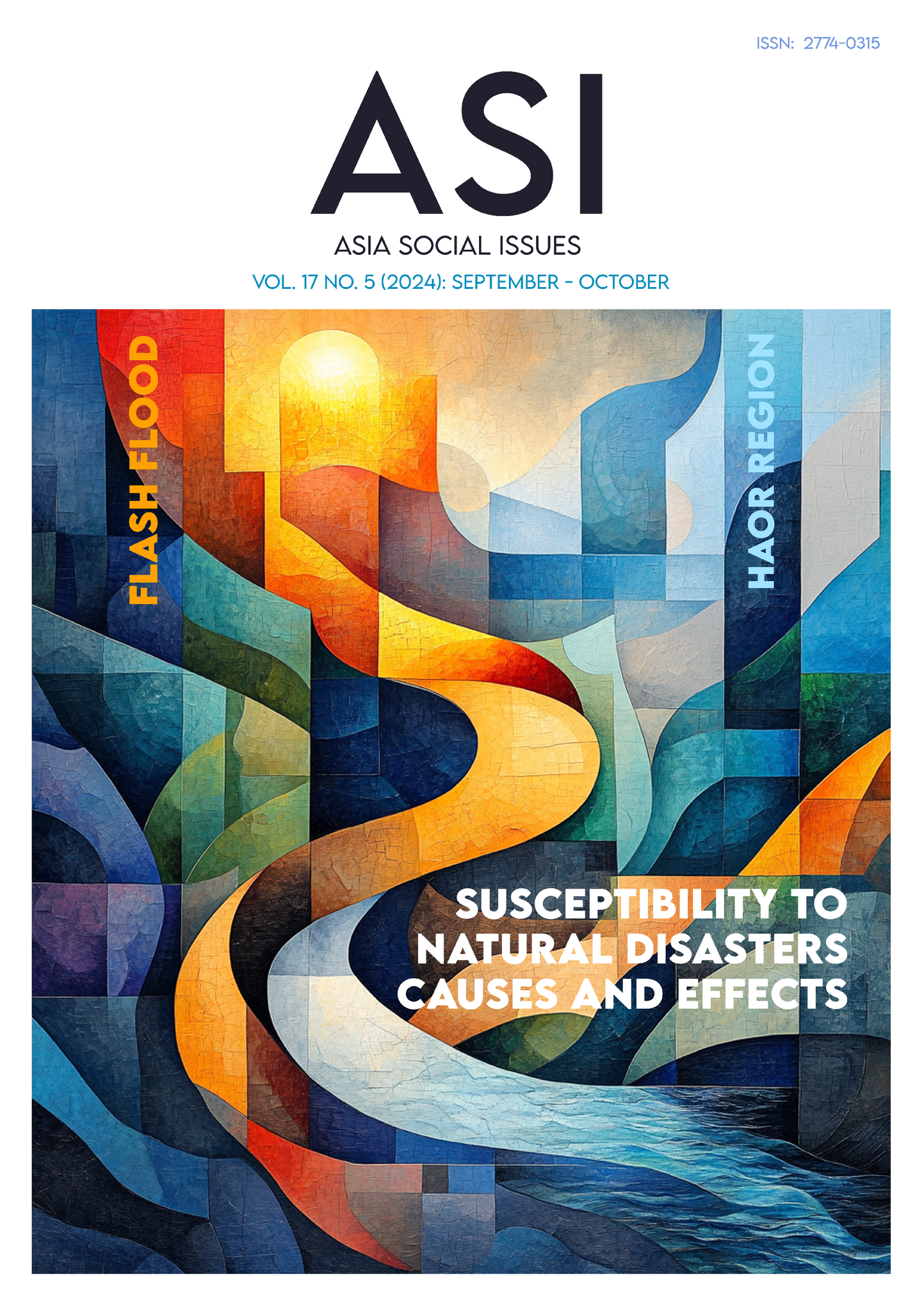Prevention Behavior and Awareness of COVID-19 Pandemic of People in Thai-Myanmar Border Area, Mae Hong Son Province, Thailand
Main Article Content
Abstract
Due to the emergence of the COVID-19 pandemic, affords have been made to block the movement of people and goods. It believed to stop the spread of germs from people and goods in the border area. Nevertheless, the people and goods there do not stand still as specified. This study employed quantitative research to investigate prevention behavior and awareness of the COVID-19 pandemic of people in the Thai-Myanmar border area, Mae Hong Son province, Thailand. A set of questionnaires was used for data collection and administered to a sample group of 406 people living near the border trade relief of Mae Hong Son province. Obtained data were analyzed using descriptive statistics, mean, and standard deviation. Based on behavior and awareness of the prevention of the COVID-19 pandemic, it was found that, as a whole, the respondents had the highest level of COVID-19 prevention behavior (x̅ = 4.24). This included the following instructions for public health personnel: social distancing, wearing a hygienic mask, hand washing, and temperature measurement. For the awareness of the prevention of the COVID-19 pandemic, it was also found at the highest level (x̅ =4.28). This included all people’s participation, communication within the household/community to prevent the COVID-19 pandemic, and strict compliance with the community’s regulations to prevent the disease. The border is a fragile area. There is a chance of transmission of pathogens caused by the movement of people and goods in border areas. The prevention of the COVID-19 pandemic of people in the Thai-Myanmar border area under behavior and awareness of disease prevention. Meanwhile, people worldwide are taking measures to reduce the risk of contracting COVID-19.
Article Details

This work is licensed under a Creative Commons Attribution-NonCommercial-NoDerivatives 4.0 International License.
Copyright: CC BY-NC-ND 4.0
References
Apidechkul, T., Upala, P., & Yeemard, F. (2022). Hill tribe community model development for preparedness and response COVID-19 epidemic, in the border area of Thailand-Myanmar. Nonthaburi, Thailand: Health Systems Research Instiute (HSRI).
Biddlestone, M., Green, R., & Douglas, K. M. (2020). Cultural orientation, power, belief in conspiracy theories, and intentions to reduce the spread of COVID-19. British Journal of Social Psychology,59, 663-673.
Center for Disease Control and Prevention. (2020). Coronavirus (Covid-19). Retrieved from https://www.cdc.gov/coronavirus/2019-ncov/index.html.
Chuenchom, P., Yodsuwan, S., Ployleaung, T., Muenchan, P., & Kanthawee, P. (2022). The development of COVID-19 epidemic management system at Thai-Laos border: A case study Chiankong district, Chiang Rai province. Chiang Rai Medical Journal,14(1), 70-91.
Department of Disease Control. (2014). Guidelines for border health operations. To support the entry into the ASEAN community fiscal year 2014. Nonthaburi, Thailand: Department of Disease Control, Ministry of Public Health.
Department of Provincial Administration, Ministry of Interior. (2022). Statistics of the population of Mae Hong Son province December 2020 data. Retrieved fromhttps://stat.bora.dopa.go.th/stat/statnew/statMONTH/statmonth/#/displayData
Farnam, A. (2021). Phenomenology of human collective consciousness confronting COVID-19: The trace of the pandemic in the humane mind. Bioimpacts, 11(3), 65-167.
Hair, J. F., Black, W. C., Babin, B. J., & Anderson, R. E. (2014). Multivariate data analysis (7th eds.). Harrow, UK: Pearson.
Joseph, T., & Ashkan, M. (2020). International Pulmonologist’s Consensus on Covid-19. India: Amrita Institute of Medical Sciences.
Khanna, A., Namita, I., Chakrabarti, R., & Kumar Indraganti, R. (2021). Does collective consciousness compromise during epidemics and pandemics? EAI Endorsed Transactions on Smart Coties,5(13), 1-7.
Koplan, J. P., Bond, T. C., Merson, M. H., Reddy, K. S., Rodriguez, M. H., Sewankambo, N. K., & Wasserheit, J. N. (2009). Towards a common definition of global health. The Lancet, 373(9679), 1993-1995.
Likhitwanwut, U. (2021). Post-pandemic future: Living with COVID-19. Retrieved from ihri.org/th/through-udoms-lens-column1/
Mahathamnuchock, S., & Kampa, N. (2021). Mae Hong Son, The Northwest border province: A challenging toward the special development area. Ganesha Journal, 17(2), 30-42.
Malahom, P., Sawangkaew, P., & Phumchagan, V. (2021). Community power and monitoring, control and prevention of COVID-19 people in border communities in Thailand-Laos.
McLaughlin, K. (2021). How life could get better (or worse) after COVID by Igor Grossmann and Oliver towards. Retrieved from https://greatergood.berkeley.edu/article/item/how_life_could_get_better_or_worse_after_covid
Moosa, I. A. (2020). The effectiveness of social distancing in containing Covid-19. Applied Economics, 52(58), 6292-6305.
Naewna Online. (2020). Mae Hong Son extends the closing time of Thai-Myanmar border trade relief points until 31 Oct. 20. Retrieved from https://www.naewna.com/local/522731.
National Statistical Office. (2021). Average monthly income of households by region and province in 2004-2021. Retrieved from http://statbbi.nso.go.th/staticreport/page/sector/th/08.aspx.
Nguyen, T. H. D. (2020). Lifting of social distancing measures: Perspectives from Vietnam. Disaster Medicine and Public Health Preparedness, 15(2), (2020), 40-42
Pliphat, T. (2019). Situations and trends of emerging and re-emerging diseases and Non-Communicable diseases in ASEAN, supporting documents for the symposium on infectious diseases and epidemiology. Bangkok, Thailand.
Roadkaew, K. (2021). Development of community empowerment, social monitoring and assisting individuals who economically and socially affected from COVID-19 pandemic. Journal of Social Work, 29(2), 189-220.
Saengsri, V., & Yothasamut, J. (2020). The review of country’s global health strategy development process and the monitoring and evaluation mechanism of global health strategy in eight countries. Journal of Health Systems Research, 14(2), 105-124.
Thairath Online. (2020). Mae Hong Son governor prepares to close the border for 15 days after the COVID-19 outbreak in Myanmar. Retrieved from https://www.thairath.co.th/news/local/north/1921569.
Tiberius, V. (2021). How life could get better (or worse) after COVID from Igor Grossmann and Oliver towards. Retrieved from https://greatergood.berkeley.edu/article/item/how_life_could_get_better_or_worse_after_covid.
Voegel, J., & Wachsman, Y. (2022). The effect of culture in containing a pandemic: The case of COVID-19. Journal of Risk Research, 25(9), 1075-1084.
Walker, A. (2018). Entanglement: The interaction between individual and collective consciousness. Collective Consciousness and Gender. London: Palgrave Macmillan
World Health Organization. (2019). COVID-19- WHO Thailand situation reports. Retrieved from https://www.who.int/thailand/emergencies/novel-coronavirus- 2019/situation-reports


